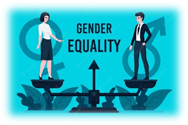

|
Overview:
|
Context
India has got another opportunity to do much better for half of its population with the Global Gender Gap Index for 2022, released by the World Economic Forum, placing it at 135 out of 146 countries.
|
Key Findings of the report:
|
Analysis
About Gender Gap Index:
|
Key Findings of the report:
|
- Published by: World Economic Forum (WEF) since the year 2006.
- Objectives: to track the performance and progress of the nation towards narrowing down the gaps between genders.
- Parameters: It benchmarks the current state and evolution of gender parity across four key dimensions:
- Political Empowerment
- Economic Participation and opportunity
- Educational attainment
- Health and survival
Status of women in India:
- In the years of the pandemic, when incomes were shrinking, Indian women faced obstacles on all fronts, from food, health and education for girls to employment.

- The latest NFHS data (2019-2021) shows that 57% of women (age group 15-49) are anemic (up from 53% in 2015-16).
- Although the number of women using a bank or savings account has increased to 78.6%, with schemes like the Pradhan Mantri Jan Dhan Yojana, their participation in the labor market has decreased.
|
About Global Gender Gap:
|
- According to data from the Center for Monitoring the Indian Economy (CMIE), around 15% of women were employed or seeking employment in 2016–17; this further reduced to 9.2% in 2021-22.
What is the status of India according to the report?
- India ranks poorly among its neighbors, behind Bangladesh, Nepal, Sri Lanka, Maldives and Bhutan.
- Only Iran, Pakistan and Afghanistan fare worse than India in the region.
- India fared worst in at least one of the parameters – “health and survival”, in which it ranked last.
</table class="table table-bordered">What are the factors contributing to the poor performance?
- There are enough numbers from the country to indicate that India, with a female population of around 66 million, has faltered on the road to gender equality.
- In the years of the pandemic, when incomes were shrinking, women faced obstacles on all fronts, from food, health and education for girls to employment.
- The latest NFHS data (2019-2021) shows that 57% of women (age group 15-49) are anemic, up from 53% in 2015-16;
- Although 88.7% of married women participate in key household decisions, only 25.4% of women aged 15-49 who worked in the last 12 months (2019-2021) were paid in cash.
- The number of women who have a bank account or a savings account they use has increased to 78.6%, helped by schemes like the Pradhan Mantri Jan Dhan Yojana, but women's labor force participation has dwindled.
- According to data from the Center for Monitoring the Indian Economy (CMIE), around 15% of women were employed or seeking employment in 2016–17; this metric dropped to 9.2% in 2021-22.
What needs to be done to achieve gender parity?
- Improve representation:
- An exception needs to be made for the Women's Reservation Act, 2008 to be passed in Parliament.
- Although pending, political parties should start nominating women for one-third of the seats.
- Gender Responsive Innovation:
- A renewed emphasis on innovation, which focuses on a gender-sensitive approach to the innovation process, the promotion of innovation by women, the promotion of innovation for the disadvantaged, and so on.
- PPP partnership:
- Promote public-private partnerships in this area, as well as recognize businesses that contribute to national gender parity goals.
- Embrace healthy public-private partnerships to support women in business and bring technology to help innovate processes, solutions and products to increase their economic participation.
- Implement the numerous schemes announced in true spirit:
- The government can start spending the allocated budgets in full and hold district collectors accountable with metrics similar to the Aspiring Districts initiative. (The Nirbhaya Fund was severely underutilized.)
- Time to upgrade "Beti-Bachao-Beti-Padhao" to "Beti-Padhao-Beti-Kamao".
- Budding India needs to develop schemes to build an ecosystem for women entrepreneurs to thrive.
- Independent body for gender parity:
- Create an independent authority like UIDAI for gender parity that can be a nodal agency for scaling up at district levels with clear goals, metrics, targets and good governance.
- It can cover many areas such as education, skills, security, transparency of participation in the informal sector in the labor market, wage parity and business opportunities for women.
- Easy availability of credit:
- Data consistently supports the fact that women with financial literacy support are more disciplined in repaying their microloans.
- Perhaps India Post could replace for-profit microfinance and provide better credit to women entrepreneurs.
- Adoption of government initiatives and policies:
- Businesses need to take government initiatives and should adopt inclusion policies that help women advance in their careers, through upskilling and "career return" programs, flexible working, special leave, pay parity, hybrid work models, etc.
- CSR funds for women-oriented work:
- Channel CSR funds more strategically towards local women's community engagement and skills. This could be in collaboration with district administrations.
- Lobby the government to add women-specific work to its core CSR focus.
|
Sub-Indices |
Rank |
Score |
|
Political empowerment |
48 |
0.267 |
|
Economic Participation and opportunity |
143 |
0.350 |
|
Educational Attainment |
107 |
0.961 |
|
Health and survival |
146 |
0.937 |
Conclusion
The best way to improve India's abysmal ranking is to do it right by women. Both government and business owe it to the "other (better) half" for their contribution to the $5 trillion economic mission. To this end, it is essential to increase the representation of women in leadership positions at all levels so that women have better access to jobs and resources. It is up to the government to overcome tokenism and help women overcome overwhelming economic and social barriers.


